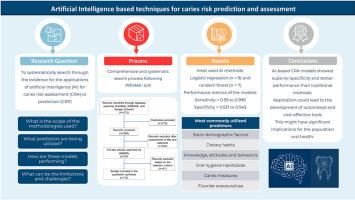Artificial intelligence based techniques for caries risk prediction and assessment: A scoping review
Q1 Medicine
Journal of oral biology and craniofacial research
Pub Date : 2025-09-10
DOI:10.1016/j.jobcr.2025.08.027
引用次数: 0
Abstract
Objective
The purpose of this scoping review was to systematically search through the evidence for the applications of artificial intelligence (AI) for caries risk assessment (CRA) or prediction (CRP), determine the scope of the methodologies used, summarize their performance metrics, and report limitations and challenges (if any).
Design
A structured and comprehensive search of three electronic databases, MEDLINE, EMBASE, and Google Scholar, was performed to yield results from 2013 to 2023. Studies were selected through title, abstract, and full-text screening based on the selection criteria. Charting of the extracted data was performed using a self-designed checklist with eight dimensions.
Results
The electronic database search retrieved 3059 articles. Ultimately, 13 articles were included in the review. The most used methods were logistic regression (n = 9) and random forest (n = 8). The performance of the included models was measured variably. The reported performance metrics of the models were heterogeneous in nature; the sensitivity ranged from 0.59 to 0.996, while the specificity ranged from 0.531 to 0.943. The most frequently utilized predictors include socio-demographic factors, oral hygiene habits, and dietary habits.
Conclusion
Of the AI-based CRA models analyzed, machine learning algorithms were most frequently used. This review highlights that AI methods most probably show superior specificity and better performance than traditional methods. The application of these algorithms can have significant implications for the population impacted by pertinent chronic diseases that are avoidable through risk reduction, such as dental caries.

基于人工智能的龋齿风险预测和评估技术:范围综述
本综述的目的是系统地检索人工智能(AI)用于龋齿风险评估(CRA)或预测(CRP)的证据,确定所使用方法的范围,总结其性能指标,并报告局限性和挑战(如果有的话)。对MEDLINE、EMBASE和谷歌Scholar三个电子数据库进行结构化和全面的检索,得出2013年至2023年的结果。根据选择标准通过标题、摘要和全文筛选来选择研究。使用自行设计的包含八个维度的检查表对提取的数据进行制图。结果电子数据库检索到文献3059篇。最终,13篇文章被纳入综述。使用最多的方法是逻辑回归(n = 9)和随机森林(n = 8)。所纳入模型的性能是可变的。报告的模型性能指标本质上是异构的;灵敏度为0.59 ~ 0.996,特异度为0.531 ~ 0.943。最常用的预测因素包括社会人口因素、口腔卫生习惯和饮食习惯。结论在分析的基于人工智能的CRA模型中,机器学习算法是最常用的。这篇综述强调了人工智能方法最有可能比传统方法表现出更好的特异性和更好的性能。这些算法的应用可以对受相关慢性疾病影响的人群产生重大影响,这些疾病可以通过降低风险来避免,例如龋齿。
本文章由计算机程序翻译,如有差异,请以英文原文为准。
求助全文
约1分钟内获得全文
求助全文
来源期刊

Journal of oral biology and craniofacial research
Medicine-Otorhinolaryngology
CiteScore
4.90
自引率
0.00%
发文量
133
审稿时长
167 days
期刊介绍:
Journal of Oral Biology and Craniofacial Research (JOBCR)is the official journal of the Craniofacial Research Foundation (CRF). The journal aims to provide a common platform for both clinical and translational research and to promote interdisciplinary sciences in craniofacial region. JOBCR publishes content that includes diseases, injuries and defects in the head, neck, face, jaws and the hard and soft tissues of the mouth and jaws and face region; diagnosis and medical management of diseases specific to the orofacial tissues and of oral manifestations of systemic diseases; studies on identifying populations at risk of oral disease or in need of specific care, and comparing regional, environmental, social, and access similarities and differences in dental care between populations; diseases of the mouth and related structures like salivary glands, temporomandibular joints, facial muscles and perioral skin; biomedical engineering, tissue engineering and stem cells. The journal publishes reviews, commentaries, peer-reviewed original research articles, short communication, and case reports.
 求助内容:
求助内容: 应助结果提醒方式:
应助结果提醒方式:


